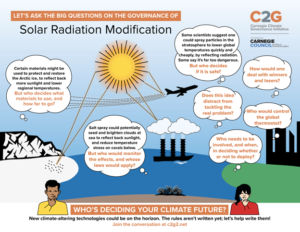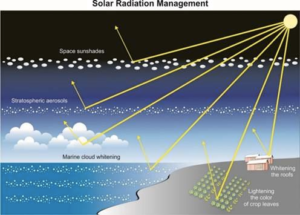Solar Radiation Management
Relevance
- GS Paper – 3, Environmental Pollution & Degradation, Conservation.
- Tags: #Solar Radiation Management.
Why in the news?
- As India had its rain-wise driest August in a century this year, solar radiation may be the cause. While scientists are yet to link this anomaly with the chaotic effects of climate change, it underscores the constant threat of disrupted weather, the resulting consequences for the economy, and the importance of climate mitigation.
- One of the more desperate, and dangerous, ideas to have emerged from this impetus is solar radiation management (SRM) to block some of the incoming solar radiation to cool the earth’s surface. SRM’s dangers emerge from the fact that it interferes with natural mechanisms with unavoidable planet-wide effects.
- For example, if an SRM experiment by one country leads to more rain over the Horn of Africa than expected, it could trigger a locust swarm that eventually destroys crops in Pakistan and India.
Solar radiation: Solar radiation management (SRM) has emerged as a potential tool to counter the effects of global warming by reflecting sunlight back into space.
A recently released report by the US government highlights the need for comprehensive research and a governance framework to assess the risks and benefits associated with SRM.
Solar Radiation Management: Solar radiation management is a form of climate engineering that aims to reduce global warming by reflecting some of the sun’s energy back into space before it can heat up the Earth. SRM is an idea born of desperation, as the world faces an ongoing and accelerating climate crisis that threatens human well-being and planetary health.
Advantages
- SRM might be able to quickly lower global temperatures, putting an end to extreme climate occurrences for the time being.
- Depending on the technique employed and the scale necessary, it can be more affordable than alternative solutions.
- If stopped or altered, SRM might be reversible in a short amount of time.
Disadvantages
- SRM was unable to address all components of climate change, including sea level rise brought on by thermal expansion, biodiversity loss, and ocean acidification.
- It might change precipitation patterns, and have an adverse impact on monsoons, droughts, storms, or agricultural yields, among other unforeseen or unfavorable side effects on regional or global climate systems.
- SRM may present ethical or geopolitical difficulties by dividing the world into winners and losers and presenting issues of fairness, equity, consent, culpability, and duty.
Some of the Most Discussed Methods of SRM
- Stratospheric Aerosol Injection (SAI): This involves injecting reflective particles, such as sulfate aerosols, into the upper atmosphere (stratosphere), where they would scatter some of the incoming solar radiation back into space. This would mimic the cooling effect of volcanic eruptions, which also release aerosols into the stratosphere.
- Marine Cloud Brightening (MCB): This involves spraying fine droplets of seawater or other substances into low-level clouds (marine stratocumulus) over the oceans, where they would act as cloud condensation nuclei and increase the reflectivity and persistence of the clouds. This would enhance the cooling effect of clouds, which already reflect about 20% of the incoming solar radiation.
MCB is considered to be more localized and reversible than SAI, but also more technically challenging and dependent on weather conditions.
Space Sunshades: This involves placing large mirrors or screens in orbit around the Earth or at a stable point between the Earth and the sun (Lagrange point 1), where they would block or deflect some of the incoming solar radiation. This would reduce the amount of solar energy reaching the Earth’s surface. Space sunshades are considered to be more controllable and adjustable than SAI or MCB, but also more expensive and complex to deploy and maintain.
Solar Radiation Management won’t stop additional environmental impacts from rising CO2 and other GHG concentrations because it doesn’t lower GHG emissions or deal with the causes of anthropogenic climate change. There is broad consensus in recent research that the deployment of SRM would therefore be at most a temporary strategy that may work in conjunction with mitigation strategies intended to produce sustainable net zero or net negative CO2 emissions globally. These hazards rise with the amount of SRM. SRM should not be considered the primary policy response to climate change as a result.
Source: The Hindu.





